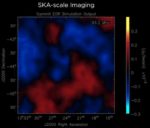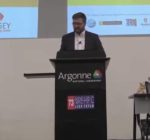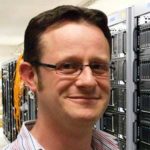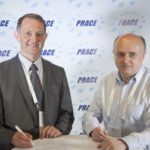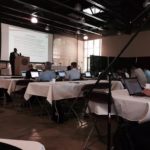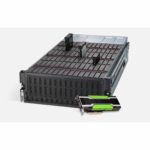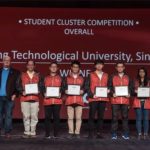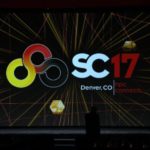Researchers are using the Summit Supercomputer at ORNL to simulate the massive dataflow of the future SKA telescope. “The SKA simulation on Summit marks the first time radio astronomy data have been processed at such a large scale and proves that scientists have the expertise, software tools, and computing resources that will be necessary to process and understand real data from the SKA.”
Video: The Pawsey Supercomputing Centre, SKA, and HPC in Australia
Mark Stickells from the Pawsey Supercomputing Centre gave this talk at the HPC User Forum. “The Pawsey Supercomputing Centre is one of two, Tier-1, High Performance Computing facilities in Australia, whose primary function is to accelerate scientific research for the benefit of the nation. Our service and expertise in supercomputing, data, cloud services and visualisation, enables research across a spread of domains including astronomy, life sciences, medicine, energy, resources and artificial intelligence.”
Exploring the Universe with the SKA Radio Telescope and CUDA
In this video, Wes Armour from the Oxford eResearch Centre discusses the role of GPUs in processing large amounts of astronomical data collected by the Square Kilometre Array and how CUDA is the best suited option for their signal processing software. “The massive computational power of modern day GPUs allows code to perform algorithms such as de-dispersion, single pulse searching and Fourier Domain Acceleration Searching in real-time on very large data-sets which are comparable to those which will be produced by next generation radio-telescopes such as the SKA.”
In a boon for HPC, Founding Members Sign SKA Observatory Treaty
Earlier this week, countries involved in the Square Kilometre Array (SKA) Project came together in Rome to sign an international treaty establishing the intergovernmental organization that will oversee the delivery of the world’s largest radio telescope. “Two of the world’s fastest supercomputers will be needed to process the unprecedented amounts of data emanating from the telescopes, with some 600 petabytes expected to be stored and distributed worldwide to the science community every year, or the equivalent of over half a million laptops worth of data.”
Pawsey teams with PRACE to promote Supercomputing
Australia’s Pawsey Supercomputing Centre and PRACE have signed a Memorandum of Understanding (MOU) to promote the use of supercomputers to the progress of scientific and technological outcomes, and to stimulate the industry sector both in Australia and Europe. “PRACE and Pawsey share the complexity and international nature of the science areas that each organization supports, the need to provide services to researchers who are spread across different time zones and the requirement of on-demand access to compute power for a scientific instrument.”
Agenda Posted for Mass Storage Conference in Santa Clara
The 34th International Conference on Massive Storage Systems and Technologies (MSST 2018) has posted their Speaker Agenda. The event takes place May 14-16 in Santa Clara, California. “Join the discussion on webscale IT, and the demand on storage systems from IoT, healthcare, scientific research, and the continuing stream of smart applications (apps) for mobile devices.”
SC17 Keynote Looks at the SKA Telescope: Life, the Universe, and Computing
In this special guest feature, Robert Roe reports from the SC17 conference keynote. “Philip Diamond, director general of SKA and Rosie Bolton, SKA regional centre project scientist and project scientist for the international engineering consortium designing the high performance computing systems used in the project, took to the stage to highlight the huge requirements for computation and data processing required by the SKA project.”
Nyriad to Accelerate Persistent Memory and GPUs for Storage
Today Netlist, Nyriad, and HPC Systems announced their joint collaboration to deliver superior throughput, IOPs and resilience for high performance Lustre storage solutions for large and small files targeted at large-scale cluster computing. “This collaboration is one of the exciting revolutions in high performance computing where larger scale solutions result in a leap in efficiency,” said Teppei Ono, President of HPC Systems. “With Nyriad’s NSULATE technology, we get higher performance and resilience the more drives we add to a node. At larger storage scales with higher throughput, we can dispense with RAID controllers and use NVDIMM’s from Netlist to achieve millions of IOPs for large and small file transactions.”
Radio Free HPC wraps up the SC17 Student Cluster Competition
In this podcast, the Radio Free HPC team goes over the results of the SC17 Student Cluster Competition. This year, Nanyang Technological University from Singapore took the Top Prize. “In this competition, student teams design and build small clusters, with hardware and software vendor partners, learn designated scientific applications, apply optimization techniques for their chosen architectures, and compete in a non-stop, 48-hour challenge, at the SC conference.”
Video Replay: SC17 Keynote Presentation on the SKA Telescope Project
We are very excited to present this live keynote presentation on the SKA Telescope Project live from SC17. It all starts here Tuesday, Nov 14 at 8:30am Mountain Time. “Professor Diamond, accompanied by Dr. Rosie Bolton, SKA Regional Centre Project Scientist, will take SC17 attendees around the globe and out into the deepest reaches of the observable universe as they describe the SKA’s international partnership that will map and study the entire sky in greater detail than ever before.”

